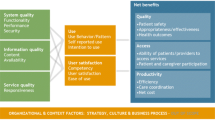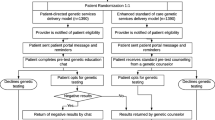ABSTRACT
BACKGROUND
There is growing interest in developing systems to overcome barriers for acquiring and interpreting family health histories in primary care.
OBJECTIVE
To examine the capacity of three different electronic portals to collect family history from patients and deposit valid data in an electronic health record (EHR).
DESIGN
Pilot trial.
PARTICIPANTS, INTERVENTION
Patients were enrolled from four primary care practices and were asked to collect family health history before a physical exam using either telephone-based interactive voice response (IVR) technology, a secure internet portal, or a waiting room laptop computer, with portal assigned by practice. Intervention practices were compared to a “usual care” practice, where there was no standard workflow to document family history (663 participants in the three intervention arms were compared to 296 participants from the control practice).
MAIN MEASURES
New documentation of any family history in a coded EHR field within 30 days of the visit. Secondary outcomes included participation rates and validity.
KEY RESULTS
Demographics varied by clinic. Documentation of new family history data was significantly higher, but modest, in each of the three intervention clinics (7.5 % for IVR clinic, 20.3 % for laptop clinic, and 23.1 % for patient portal clinic) versus the control clinic (1.7 %). Patient-entered data on common conditions in first degree relatives was confirmed as valid by a genetic counselor for the majority of cases (ranging from 64 to 82 % in the different arms).
CONCLUSIONS
Within primary care practices, valid patient entered family health history data can be obtained electronically at higher rates than a standard of care that depends on provider-entered data. Further research is needed to determine how best to match different portals to individual patient preference, how the tools can best be integrated with provider workflow, and to assess how they impact the use of screening and prevention.

Similar content being viewed by others
REFERENCES
Claassen L, Henneman L, Janssens AC, et al. Using family history information to promote healthy lifestyles and prevent diseases; a discussion of the evidence. BMC Publ Health. 2010;10:248.
Sabatino SA, Habarta N, Baron RC, et al. Interventions to increase recommendation and delivery of screening for breast, cervical, and colorectal cancers by healthcare providers systematic reviews of provider assessment and feedback and provider incentives. Am J Prev Med. 2008;35(1 Suppl):S67–S74.
Awareness of family health history as a risk factor for disease--United States, 2004. Mmwr. 2004;53(44):1044–1047.
Yarnall KS, Pollak KI, Ostbye T, Krause KM, Michener JL. Primary care: is there enough time for prevention? Am J Public Health. 2003;93(4):635–641.
Murff HJ, Greevy RA, Syngal S. The comprehensiveness of family cancer history assessments in primary care. Community Genet. 2007;10(3):174–180.
Wilson BJ, Qureshi N, Santaguida P, et al. Systematic review: family history in risk assessment for common diseases. Ann Intern Med. 2009;151(12):878–885.
Yoon PW, Scheuner MT, Jorgensen C, Khoury MJ. Developing family healthware, a family history screening tool to prevent common chronic diseases. Prev Chronic Dis. 2009;6(1):A33.
Berg AO, Baird MA, Botkin JR, et al. National institutes of health state-of-the-science conference statement: family history and improving Health. Ann Intern Med. 2009;151(12):872–877.
Blumenthal D, Tavenner M. The “meaningful use” regulation for electronic health records. N Engl J Med. Jul 13 2010.
Qureshi N, Armstrong S, Dhiman P, et al. Effect of adding systematic family history enquiry to cardiovascular disease risk assessment in primary care: a matched-pair, cluster randomized trial. Ann Intern Med. 2012;156(4):253–262.
Doerr M, Teng K. Family history: Still relevant in the genomics era. Cleve Clin J Med. 2012;79(5):331–336.
Lupski JR, Reid JG, Gonzaga-Jauregui C, et al. Whole-genome sequencing in a patient with Charcot-Marie-Tooth neuropathy. N Engl J Med. 2010;362(13):1181–1191.
Poon EG, Wald J, Bates DW, Middleton B, Kuperman GJ, Gandhi TK. Supporting patient care beyond the clinical encounter: three informatics innovations from partners health care. AMIA Annu Symp Proc. 2003:1072.
Facio FM, Feero WG, Linn A, Oden N, Manickam K, Biesecker LG. Validation of my family health portrait for six common heritable conditions. Genet Med. 2010;12(6):370–375.
Qureshi N, Wilson B, Santaguida P, et al. Collection and Use of Cancer Family History in Primary Care. Evidence Report/Technology Assessment. Rockville: Agency for Healthcare Research and Quality; 2007.
Lorence D, Park H. Group disparities and health information: a study of online access for the underserved. Health Inform J. 2008;14(1):29–38.
Qureshi N, Wilson B, Santaguida P, et al. Collection and use of cancer family history in primary care. Evid Rep Technol Assess (Full Rep). 2007(159):1–84.
Orlando LA, Hauser ER, Christianson C, et al. Protocol for implementation of family health history collection and decision support into primary care using a computerized family health history system. BMC Heal Serv Res. 2011;11:264.
Suther S, Goodson P. Barriers to the provision of genetic services by primary care physicians: a systematic review of the literature. Genet Med. 2003;5(2):70–76.
Health Information Technology: Standards, Implementation Specifications, and Certification Criteria for Electronic Health Record Technology, 2014 Edition; Revisions tothe Permanent Certification Program for Health Information Technology. In: Services DoHaH, ed. Vol 45 CFR Part 170. Federal Register2012.
Ruffin MT, Nease DE, Ruffin MT, Nease DE Jr, Sen A, et al. Effect of preventive messages tailored to family history on health behaviors: the Family Healthware Impact Trial. Ann Fam Med. 2011;9(1):3–11.
Emery J, Morris H, Goodchild R, et al. The GRAIDS Trial: a cluster randomised controlled trial of computer decision support for the management of familial cancer risk in primary care. Br J Cancer. 2007;97(4):486–493.
Acheson LS, Zyzanski SJ, Stange KC, Deptowicz A, Wiesner GL. Validation of a self-administered, computerized tool for collecting and displaying the family history of cancer. J Clin Oncol. 2006;24(34):5395–5402.
Baer HJ, Schneider LI, Colditz GA, et al. Evaluation of a web-based risk assessment tool in the primary care setting. Paper presented at: Society for General Internal Medicine Annual Meeting, 2012; Orlando, FL.
Krist AH, Woolf SH, Rothemich SF, et al. Interactive preventive health record to enhance delivery of recommended care: a randomized trial. Ann Fam Med. 2012;10(4):312–319.
Wright A, Poon EG, Wald J, et al. Randomized controlled trial of health maintenance reminders provided directly to patients through an electronic PHR. J Gen Intern Med. 2012;27(1):85–92.
Simon C, Acheson L, Burant C, et al. Patient interest in recording family histories of cancer via the Internet. Genet Med. 2008;10(12):895–902.
Qureshi N, Armstrong S, Dhiman P, et al. Effect of adding systematic family history enquiry to cardiovascular disease risk assessment in primary care: a matched-pair, cluster randomized trial. Ann Intern Med. 2012;156(4):253–262.
Vogel TJ, Stoops K, Bennett RL, Miller M, Swisher EM. A self-administered family history questionnaire improves identification of women who warrant referral to genetic counseling for hereditary cancer risk. Gynecol Oncol. 2012;125(3):693–698.
Smith RA, Kerlikowske K, Miglioretti DL, Kalager M. Clinical decisions. Mammography screening for breast cancer. N Engl J Med. 2012;367(21):e31.
Acknowledgements
This project was supported by Award Number RC1HG005331 using American Recovery and Reinvestment Act (ARRA) funds from the National Human Genome Research Institute, and by Award Number U54CA163307 from the National Cancer Institute.
Conflict of Interest
The authors declare that they do not have a conflict of interest.
Author information
Authors and Affiliations
Corresponding author
Electronic supplementary material
Below is the link to the electronic supplementary material.
ESM 1
(PDF 44 kb)
Rights and permissions
About this article
Cite this article
Murray, M.F., Giovanni, M.A., Klinger, E. et al. Comparing Electronic Health Record Portals to Obtain Patient-Entered Family Health History in Primary Care. J GEN INTERN MED 28, 1558–1564 (2013). https://doi.org/10.1007/s11606-013-2442-0
Received:
Revised:
Accepted:
Published:
Issue Date:
DOI: https://doi.org/10.1007/s11606-013-2442-0




